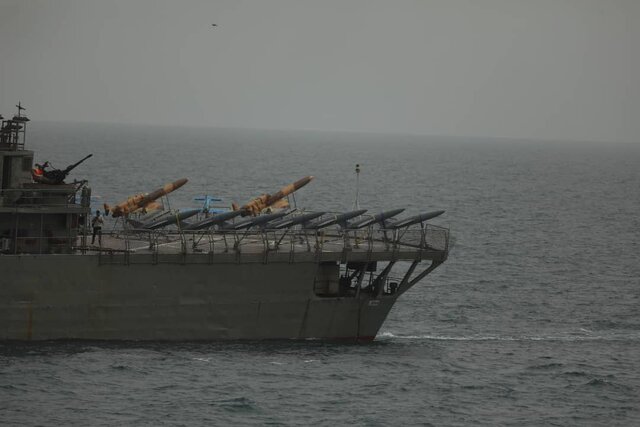
An Iranian Navy helicopter drops a Mark-46 torpedo on 31 December 2022 during Zulfiqar 1401 joint exercises.
“Torpedoes fired from Fateh and Ghadir-class submarines also destroyed their targets.”
Every year, the Iranian military hosts the Zulfiqar joint military exercises to demonstrate air, naval, and ground components from both the Islamic Revolutionary Guard Corps (IRGC) and regular army, often acting in concert.[i] As detailed in the accompanying article from the pro-regime Iranian Students’ New Agency, the most recent exercises occurred in late December 2022. They spanned the Persian Gulf, Strait of Hormuz, and northern Indian Ocean, and featured demonstrations of Iran’s indigenous Mi’ad (vow) torpedoes launched from Kilo-class Tareq attack submarines against naval targets and Valfajr torpedoes launched from Qadir submarines.[ii] The exercises also included Iranian Army Sikorsky SH helicopters launching Mark-46 torpedoes. While it is not possible yet to assess whether the capabilities of Iran’s indigenous torpedoes match the promise of regime officials, the emphasis on torpedo development and multiple launch platforms underscores the danger that increased Iranian capabilities may pose to shipping in the Persian Gulf and northern Indian Ocean. The Persian Gulf is both narrow and shallow. After the U.S. defeat of the Iranian navy and air force in 1988’s Operation Praying Mantis, IRGC tactics shifted.[iii] Rather than risk direct confrontation with large ships or jet fighters, the IRGC-Navy embraced small speed boats as a low-cost, low-risk way to harass warships and commercial traffic. The development of torpedoes may mark a further shift in strategy that could make IRGC speedboat operations obsolete.
Source:
“Shalik-e Azhdarha-ye Mi’ad va Valfajr az Zirdarya-yehaye Niru-ye Artesh (Firing of Iranian Mi’ad and Valfajr Torpedoes from Navy Submarines),” Iranian Students’ News Agency (a semi-official student-run news agency that promotes the Iranian government’s line). 1 January 2023, https://www.isna.ir/news/1401101106235
During the operational phase of the army’s Zulfiqar 1401 joint exercise, the Iranian torpedo Mi’ad fired from a Tareq [Attack] submarine for the first time and destroyed its target… Iranian Valfajr-2 torpedoes fired from Fateh and Ghadir-class submarines also destroyed their targets in the Oman Sea and northern Indian Ocean. A SH helicopter also hit its target at sea by launching the Mark-46 torpedo. These types of torpedoes are designed and manufactured by young navy specialists in collaboration with the country’s scientific centers and defense industries…. Valfajr intelligent torpedoes combine anti-deception capability, high speed and an explosive warhead with great destructive capacity, and are able to strike with surprise and completely destroy and sink large sea targets and vessels within seconds. They also boast short preparation time that increase tactical power, speed of action and rapid response compared to similar torpedoes.
Notes:
[i] Zulfiqar is a Persian rendition of the Arabic Du-l-Faqir, Imam Ali bin Abi Talib’s legendary split tip sword. Shi’ite Muslims consider the Imam Ali (600-661) to be the rightful successor to the Prophet Muhammad.
[ii] For more on the Valfajr torpedo, see: Michael Rubin, “Iran: Submarine-to-Surface Missile Launch System Entered Mass Production,” OE Watch, January 2021. https://community.apan.org/wg/tradoc-g2/fmso/m/oe-watch-articles-2-singular-format/380351
[iii] Operation Praying Mantis was a 1988 operation by the U.S. military to retaliate against Iran’s mining of the Persian Gulf and Gulf of Oman. For greater background, see: Lee Allen Zatarain, America’s First Clash with Iran: The Tanker War, 1987–88. Philadelphia: Casemate, 2008.
Image Information:
Image: An Iranian Navy helicopter drops a Mark-46 torpedo on 31 December 2022 during Zulfiqar 1401 joint exercises.
Source: https://cdn.isna.ir/d/2023/01/01/3/62473566.jpg?ts=1672563255357
Attribution: Iranian Students’ News Agency

